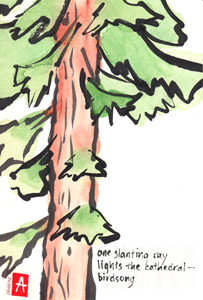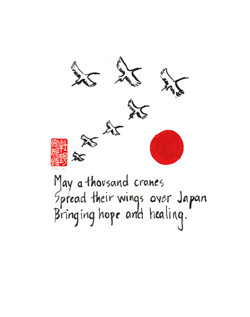By KAREN RIFKIN for the Ukiah Daily Journal
Ukiah, California
April 30, 2013
On a hot Sunday afternoon the seats at SPACE’s auditorium are filling as the judges/poet laureate committee members are taking theirs on the stage. Retired English teacher and Ukiah city councilman Benj Thomas welcomes the audience to the Eleventh Annual ukiahHaiku Festival. He briefly explains – haiku poems open things up; they are non restrictive.
Ukiah’s poet laureate Dan Barth introduces the keynote speaker, Bart Schneider who reads from his book, the protagonist is a poetry-loving detective hoping to open a poetry bar in Cazadero.
Barth explains, “We no longer insist on the five, seven, five form five syllable in the first line, seven in the second and five in the third – for the 1,023 haiku entries we received this year. It is a fluid form; the English language is not the same as the Japanese.
“Those here are the crème de la crème. The majority of entries were from poets in the state of California’s Mendocino, Lake, Humboldt and Sonoma Counties.
“For the Jane Reichhold International Prize category, entries were received from three continents, five countries and thirteen states and we are pleased to present the first place prize to our very own Armand Brint.”
sunless day
a child’s yellow comb
on the sidewalk
–Armand Brint
Brint talks about the prize and what it means to him.
“We expanded the competition to include this international prize about three or four years ago,” he explained. “Reichhold, a coast resident, is a well-known, internationally recognized poet, expert both in writing haiku and about them. She suggested we include the category in our festival and we were honored to have her participation.
“I have been studying, writing, and teaching haiku for a number of years,” Brint continued, “and I was particularly interested in submitting for this juried international competition. The category attracts haiku writers from all over the world, many of them experienced; I was very honored and excited to receive first prize.
“Entries tend to be more contemporary and western; they don’t adhere to any syllable structure. The three lines follow the short, long, short form but not the five, seven, five. It is non restrictive. The Japanese language is divided into sound units instead of syllables so there is really no direct correspondence.
“Entries for this category comply with the typical haiku requirements – seasonal, a recording of a moment in nature – evoking what the poet feels, rendering it in very simple, concrete objective language. It looks easy because it is short and non-rhyming and although the form is simple, it is not easy. It is very different from what we consider lyrical poetry; there is no figurative language, no human interaction in the poem. You have to be able to quiet your mind enough to absorb that single evocative moment.”
The young, the old and the very young take their turn on stage reading their haiku in both English and Spanish, carefully and twice, to the appreciative audience.
rusty old car parts
broken down coated with dirt
alongside Orr Creek
–Casey Snodgrass
Casey, a 2nd grader in Mrs. Carter’s class at Frank Zeek, won first prize in the K-6 category about Ukiah. He explains his process. “We were on a hike for a field trip at Low Gap Park where we got to play. When it was time to go home we were walking and I saw the old cars on the side of the road. They were all rusty and covered with dust. Our teacher gave us a piece of paper and a pencil so we could write down stuff we saw. When I got back to the classroom she helped me spell some words.”
golden hills
turkey vultures circle the remains
of summer
–Annette Makino
Makino, who is originally from Redwood Valley and now lives in Humboldt County, won first prize both in the adult general category and adult haiku about Ukiah. “I started writing haiku in 2010 and combine the poems with Japanese ink paintings. This is part of a tradition in Japan called Haiga; the words and the images deepen the meaning. I also enjoy creating a related form of Japanese poetry called Senryu; although similar to haiku the poems are generally humorous and have more to do with human nature. My inspiration comes from everyday life: my children, my dogs, the landscape in northern California.
“I was very excited to win; I am originally from here and am happy to see my old home encouraging haiku poets of all ages,” Makino said.






